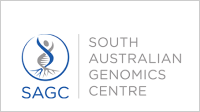Questions about MGI sequencing?
The SAGC offers both MGI and Illumina short-read NGS platforms – small, mid and high-throughput sequencers. This breadth of options enables us to better match to project requirements and gives our clients the most efficient and cost-effective sequencing options.
The SAGC is the Only Core Genomics Facility in Australia with both the MGI DNBSEQ-T7 and DNBSEQ-G400, covering a wide range of throughput from 200 million to 24 billion read pairs with cost effectiveness. The ultra high-speed T7 can run 1 to 4 flow cells independently (each generating up to 6 billion read pairs depending on library type). The mid-throughput DNBSEQ-G400 is capable of running 4 lanes independently.

Having this wide range of sequencers and more flexible formats reduces the need for pooling samples and improves turnaround time.
Sample throughput by Application Type for MGI DNBSEQ G400 and T7 Sequencers%20Tissue%20storage%20reagent%20allows%20storage%20up%20to%2072%20hrs%20for%20sample%20pooling.png?width=1024&height=768&name=Either%20gene%20expression%20or%20ATAC%20single%20cell%20Run%201-4%20samples%20at%20a%20time%20(up%20to%2020K%20cells%20per%20sample)%20Tissue%20storage%20reagent%20allows%20storage%20up%20to%2072%20hrs%20for%20sample%20pooling.png)
This stems from differences with the sequencing chemistry. Both use optical reading of fluorescent nucleotides, however, Illumina uses ‘bridge amplification’ to replicate the same DNA fragments to improve signal detection. MGI’s DNBseq technology involves the generation of nanoscale DNA balls through rolling circle amplification.
Enabling Single Cell and Spatial Profiling from MGI
In addition to running any standard large genomics applications (i.e., WGS, WES, RNA-seq, single-cell), MGI sequencing is required for MGI spatial profiling (STOmics) and MGI single-cell libraries (C4).
.png?width=1024&height=768&name=MGI%20Article_Table%20of%20Sequencer%20and%20Applications%20(1).png)
How does MGI data compare with Illumina?
Many peer-reviewed bench-marking studies have been published comparing MGI sequencing across different applications with Illumina and other NGS platforms (see references below). The SAGC has performed its own head-to-head comparisons and made the following overall conclusions from these data sets:
- Overall quality and accuracy were very good and highly correlated across platforms.
- More reads were mapped to genes and transcripts with MGI data.
.png?width=795&height=284&name=Untitled%20design%20(19).png)
Other Comparison Studies:
- Kim, H.-M. et al. Comparative analysis of 7 short-read sequencing platforms using the Korean Reference Genome: MGI and Illumina sequencing benchmark for whole-genome sequencing. GigaScience 10, giab014 (2021).
- Jeon, S. A. et al. Comparison between MGI and Illumina sequencing platforms for whole genome sequencing. Genes Genom 43, 713–724 (2021).
- Patterson, J. et al. Impact of sequencing depth and technology on de novo RNA-Seq assembly. BMC Genomics 20, 604 (2019).
- Li, Q. et al. Reliable multiplex sequencing with rare index mis-assignment on DNB-based NGS platform. BMC Genomics 20, 215 (2019).
Touch base if you have questions or if you would like to book a free project consultation.
Why the SAGC?
- ISO/IEC 17025 Accredited Laboratory
- Best NGS Economics in Australia
- Only Genomics Core Offering 3x Spatial Transcriptomics Platforms
- Dedicated Bioinformatics Team

.png?width=300&name=Untitled%20design%20(18).png)